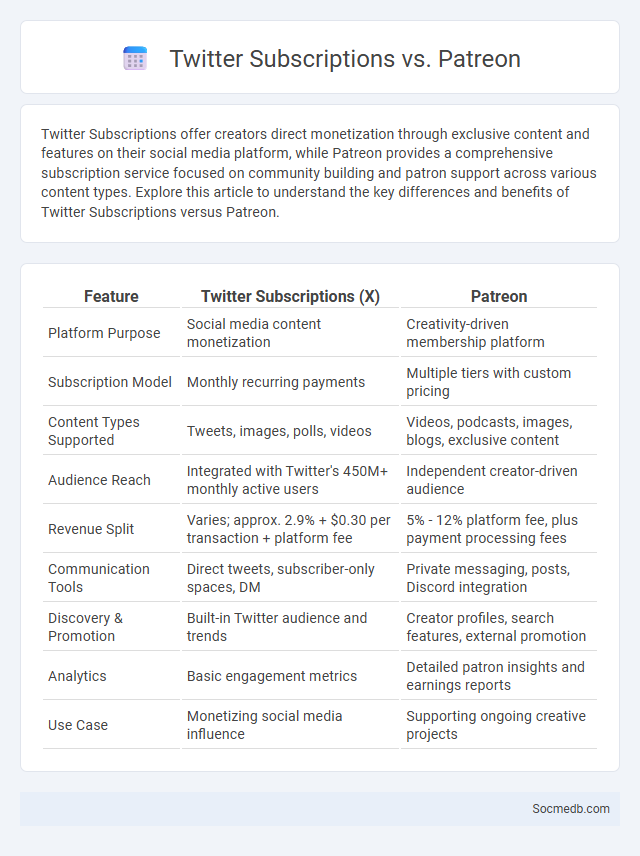
Photo illustration: Twitter Subscriptions vs Patreon
Twitter Subscriptions offer creators direct monetization through exclusive content and features on their social media platform, while Patreon provides a comprehensive subscription service focused on community building and patron support across various content types. Explore this article to understand the key differences and benefits of Twitter Subscriptions versus Patreon.
Table of Comparison
| Feature | Twitter Subscriptions (X) | Patreon |
|---|---|---|
| Platform Purpose | Social media content monetization | Creativity-driven membership platform |
| Subscription Model | Monthly recurring payments | Multiple tiers with custom pricing |
| Content Types Supported | Tweets, images, polls, videos | Videos, podcasts, images, blogs, exclusive content |
| Audience Reach | Integrated with Twitter's 450M+ monthly active users | Independent creator-driven audience |
| Revenue Split | Varies; approx. 2.9% + $0.30 per transaction + platform fee | 5% - 12% platform fee, plus payment processing fees |
| Communication Tools | Direct tweets, subscriber-only spaces, DM | Private messaging, posts, Discord integration |
| Discovery & Promotion | Built-in Twitter audience and trends | Creator profiles, search features, external promotion |
| Analytics | Basic engagement metrics | Detailed patron insights and earnings reports |
| Use Case | Monetizing social media influence | Supporting ongoing creative projects |
Introduction to Creator Monetization Platforms
Creator monetization platforms empower social media users to generate income from their content by facilitating direct support from followers and enabling brand partnerships. These platforms offer tools like subscription services, tipping features, and exclusive content access to maximize your revenue streams. Understanding these systems enhances your ability to turn creative efforts into sustainable financial opportunities.
Overview of Twitter Subscriptions
Twitter Subscriptions offer exclusive content and features for users who pay a monthly fee, enhancing engagement between creators and followers. These subscriptions enable creators to provide subscriber-only tweets, community access, and ad-free experiences, boosting platform monetization. The service supports a growing number of influencers, journalists, and brands seeking direct revenue streams through tailored content delivery.
What is Patreon?
Patreon is a membership platform that allows creators to earn recurring revenue by providing exclusive content and rewards to their subscribers, known as patrons. It supports various creator types including artists, writers, podcasters, and video producers through tiered membership plans with benefits such as early access, behind-the-scenes content, and personalized interactions. Patreon integrates with social media platforms to help creators grow their audience and monetize their work directly from fans.
Key Features Comparison
Social media platforms differ significantly in user engagement tools, content formats, and audience demographics. Instagram emphasizes visual storytelling with features like Stories, Reels, and IGTV, catering to younger audiences, while LinkedIn focuses on professional networking through articles, job postings, and endorsements. Understanding these key features helps you select the platform that best aligns with your marketing goals and target audience.
Pricing and Revenue Share
Social media platforms typically generate revenue through advertising, subscription models, and premium features, with pricing strategies varying based on user engagement and market demand. Many platforms offer tiered pricing plans, allowing businesses and influencers to select packages that match their growth goals and budget. Understanding your target audience and platform-specific revenue share policies can help you optimize monetization strategies effectively.
Audience Engagement Tools
Audience engagement tools on social media enhance your ability to connect with followers through interactive features such as polls, live videos, and story stickers. These tools increase user participation, boost content visibility, and provide valuable feedback for refining marketing strategies. Leveraging analytics from these tools helps you tailor content that resonates deeply with your target audience, driving higher engagement rates.
Payment and Payout Options
Social media platforms increasingly support diverse payment and payout options, including credit cards, digital wallets like PayPal and Apple Pay, and cryptocurrency transactions to facilitate seamless financial exchanges. Influencers and businesses benefit from integrated payout systems such as direct bank transfers, Payoneer, and automated payout schedules to ensure timely revenue disbursement. These advanced payment solutions improve user experience by offering secure, fast, and flexible financial operations essential for monetization and e-commerce activities on social media.
Pros and Cons of Each Platform
Facebook offers extensive networking opportunities and robust advertising tools, but it faces privacy concerns and declining youth engagement. Instagram excels in visual content sharing and influencer marketing, yet it can contribute to unrealistic body image standards and algorithm-driven content overload. Twitter provides real-time news and open dialogue, though it struggles with misinformation and character limits that can oversimplify complex issues; understanding these platforms helps you maximize benefits while mitigating risks.
Best Use Cases for Creators
Social media platforms offer creators diverse opportunities for audience engagement, brand building, and monetization through content sharing, live streaming, and collaboration. Instagram and TikTok excel for visual storytelling and viral short-form content, while YouTube provides a robust platform for long-form videos and in-depth tutorials. Leveraging analytics tools enhances creators' ability to tailor content strategically, maximizing reach and impact across target demographics.
Choosing the Right Monetization Path
Choosing the right monetization path on social media depends on understanding your audience's preferences and engagement patterns. Platforms like YouTube favor ad revenue, while Instagram and TikTok emphasize brand partnerships and sponsored content for maximum earnings. You can optimize your revenue by analyzing platform-specific tools and aligning your content strategy with monetization opportunities tailored to your niche.
 socmedb.com
socmedb.com